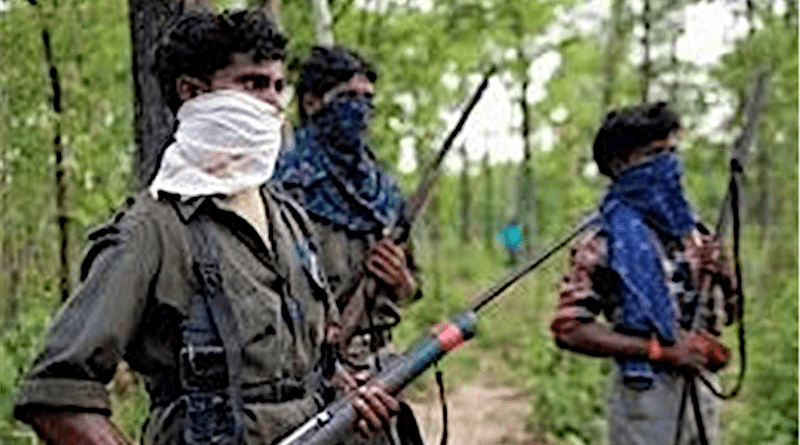Chhattisgarh’s Maoist Challenge: Is Over-Reliance On ‘Local’ Forces A Mistake? – Analysis
The explosion of an improvised explosive device (IED), possibly weighing 50 kg—which killed 10 District Reserve Guard (DRG) personnel and a civilian driver—in Chhattisgarh’s Dantewada district on 28 April brings back national attention to the somewhat forgotten, though persistent, challenge of left-wing extremism (LWE). LWE in India, despite its present state of weakness, seems to retain the capacity to strike occasionally. More importantly, it also appears that the state’s counter-LWE strategy, which somewhat blindly relies on a ‘local’ force to lead it to victory against the extremists, may need revisiting.
Since its inception in 2008 for anti-LWE operations in Kanker and Narayanpur, the DRG’s operations have been periodically expanded: to Bijapur and Bastar in 2013; Sukma and Kondagaon in 2014; and Dantewada in 2015. Comprised of youth drawn from Chhattisgarh’s tribal districts and surrendered Communist Party of India-Maoist (CPI-Maoist) cadres, the estimated 1,700 personnel-strong DRG has been repeatedly described as an effective force against the extremists. This assessment is based on their knowledge of the local terrain and conditions, language skills, and knowledge of the CPI-Maoist’s workings. The DRG’s success led to the induction of women into the force in 2019.
This ‘local’ force—similar to the Central Reserve Police Force’s (CRPF) Bastariya battalion or Battalion 241 that was raised in 2017, comprising youth from Bastar—could also strike a chord with the tribal population for being ‘their own’. The DRF was possibly able to generate better human intelligence and added sting to counter-LWE operations, more so than the central armed police forces (CAPFs). The DRG effectively legalised the civilian vigilante ‘salwa judum’ concept, which was declared illegal by the Supreme Court in 2011. Conventional counter-insurgency (COIN) doctrines underline the importance of the ‘local’ police force over the central forces. The DRG fits this bill. This economised the war on extremism, as DRG personnel receive far less pay than state police personnel and the CAPFs.
The DRG’s deployment and perceived success, however, comes at a cost. Having undergone minimal training, DRG personnel are far less enthusiastic about respecting standard operating procedures, which has led to frequent battlefield setbacks. Media reports on the 28 April ambush point to how the DRG may have ignored tell-tale signs of an impending attack.
Minimal training and a carte blanche to go after the extremists could have also diminished respect for human rights while conducting operations. A number of allegations over the years suggest that in a bid to portray effectiveness, the DRG may have been involved in fake killings, torture, and rape of civilians and suspected extremists. One of the most prominent cases is the killing of 15 alleged Maoists in a forested area of Sukma in August 2018. The victims’ relatives and other villagers alleged that the killed were innocent civilians with no connections with the CPI-Maoist. The incident occurred five months after the Maoist ambush in the same district, which killed 9 CRPF personnel.
By 2015, the DRG’s small action teams were conducting nearly 650 operations annually. Over the years, it has become the mainstay of Chhattisgarh’s LWE operations, halting the state’s perfunctory attempts to put together a specialised counter-LWE commando force. Unlike Andhra Pradesh, Telangana, Maharashtra, and Odisha, Chhattisgarh still lacks such a force. Repeated acknowledgments of the DRG’s ‘stupendous achievement’ by senior police officials in Chhattisgarh may in fact be a tactic to hide their own failure to recruit and deploy a specialised counter-LWE force.
Despite the prominence it has been assigned, the DRG may also have become a dispensable force, fulfilling a twin objective: fighting the extremists while protecting the state police and CAPFs from harm’s way. By 2020, the DRG, along with the special task force (STF), were conducting ‘deep penetrating operations’ into core LWE areas, which explains why a bulk of the fatalities from within the security forces were from the DRG. During an operation in March 2020 in the Sukma, Maoists ambushed a DRG and STF team, killing 17 personnel. 12 of them were from the DRG. Many of them bled to death due to the absence of evacuation support.
The 28 April ambush is a morale booster for the CPI-Maoist, which is trying to keep its flock together. A lone successful attack, however, is unlikely to revive the weakened outfit. Nor will it temper the official strategy of keeping the DRG in the lead. The attack instead demonstrates the limitations of over-relying on the ‘local’ force. Although Chhattisgarh is probably its last bastion, the CPI-Maoist is no longer a dominant force. Dealing with it does not require a military blitzkrieg but a methodical strategy to drain it off its remaining strength. The DRG’s support-providing role in the overall COIN strategy should be defined accordingly.
This article was also published at IPCS

